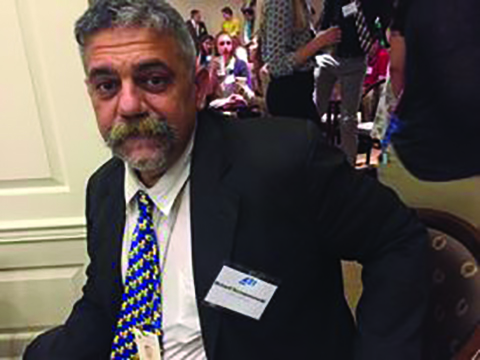One hundred years ago today – May 18, 1920 – Karol Wojtyla was born in Poland. Losing his mother and a brother when he was young, Karol and his father lived quiet, simple and pious lives.
As a young adult, Karol enjoyed writing poetry and plays and acting in amateur theater. Fluent in eight languages, he worked as a laborer in a limestone quarry before entering the seminary and becoming a priest and later bishop, archbishop and cardinal.
I believe he would have been content serving as the cardinal archbishop of Krakow.
But, happily for us, God had other plans.
On Oct. 16, 1978, a puff of white smoke from the Sistine Chapel alerted the world that Cardinal Karol Wojtyla was elected pope, taking the name John Paul II. From the very beginning of his pontificate, this now-saint grabbed our affection and our admiration. One hundred years after his birth and 15 years after his death, Saint John Paul II still has them.
John Paul II was pope for 26 years when he died on April 2, 2005. He was the fourth-longest serving pope in history, and was elected after Pope John Paul I, one of the shortest reigning popes in history.
On April 27, 2014, Pope Francis canonized Pope John Paul II along with Pope John XXIII. Up until then, of the 266 popes who led the Catholic Church, only 79 were declared saints. John Paul and John XXIII were the 80th and 81st to be so declared. Later that same year in October, Francis canonized Pope Paul VI, the 82nd pontiff to be made a saint.
On the centenary of the birth of this great and saintly pope, I think back on the 26 years he served as the Vicar of Christ and spiritual father to more than a billion Catholics around the world.
For the first 20 years of my nearly 35-year career with the Catholic Standard, John Paul II was my – our – pope. I am old enough to remember Paul VI and John Paul I, but it was under the leadership of this dear and much-loved pope that I matured in my faith.
On that October evening in 1978 when he was elected pope, he stood on the balcony at St. Peter’s and introduced himself to us as “from a faraway land.” As we – perhaps those of us of Polish descent a little more than others – celebrated this new successor to St. Peter, we could not have guessed that this pope would make history and change history.
He was the first non-Italian pope in 455 years, and the first pope to come from Eastern Europe.
St. John Paul II was the first pope to use the Internet, the first pope to send an e-mail, the first pope to visit a synagogue and the first pope to visit a mosque. He traveled more than any pope in history – more than 800,000 miles - visiting about 130 different countries.
No longer a remote personage and virtual recluse in the Vatican, the role of pope was revolutionized by John Paul II to include traveling to those who could come to him, regularly meeting with the world’s young people, and stressing the Church’s voice in world events.
John Paul II literally proclaimed the Gospel to all corners of the earth.
John Paul II was a strong man – he survived both Nazi and communist totalitarianism - but he never appeared stronger than when he was humble.
The two most indelible memories I have of the pope are his 1983 meeting with his would-be assassin, Mehmet Ali Agca, and his 2000 Holy Year pilgrimage to the Holy Land where he prayed at the Western Wall. Both memories, one from near the beginning of his papacy and the other near the end, speak volumes about this saint.
In meeting Agca (and more importantly, in forgiving him), John Paul showed the world that being merciful is not just an ideal or a concept, but an actual, attainable and authentic way of living.
In his historic visit to Israel, he healed a long and hurtful rift with the Jewish people. Again, his humility was his strength. During that pilgrimage, he remembered those Jews who died in the Holocaust and asked forgiveness for the inaction of Christians who did not assist our Jewish brothers and sisters in their suffering. At Yad Vashem, Israel’s memorial to the victims of the Shoa, the pope prayed, wept, lit a memorial flame and met with Holocaust survivors. At the Western Wall, a frail, shaking and very sick pope prayed at Judaism’s holiest site and added his written prayer to the countless millions that have been left there.
This holy pope indeed affected world and Church history.
He helped the people of Poland establish the Solidarity movement, which eventually led to the collapse of communism in 1991. He reestablished diplomatic ties between the Vatican and Israel. He changed the rosary, adding five new “luminous mysteries.” He issued the new Catechism of the Catholic Church, the first universal catechism in 500 years. He also canonized 473 new saints, more than any other pope in history.
He wrote many encyclicals including those on Jesus, Mary, mercy, economics and labor, religion and culture, and the priesthood. He also wrote the book, “Crossing the Threshold of Hope,” which became a bestseller around the world.
All of that – John Paul II’s travels, his writings, his faith – were meant to serve us on our path to holiness.
The Jewish people, whom John Paul loved and respected, have a prayer that is fitting to remember during this 100th anniversary his birth: “Blessed be the memory of the righteous.” Indeed, St. John Paull II was righteous and his memory is our blessing.
During this frightful time of the COVID-19 pandemic, I think of John Paul II’s frequent admonition: “Be not afraid!” Could any other words be more fitting at this time? That indeed is our blessing.












